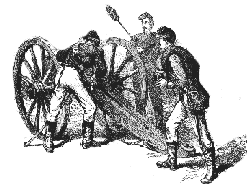
Pulaski Light Artillery

A Brief History
![]()
Roster of the 107 members of the Pulaski Light Artillery, April 20 to September 2, 1861.

Pulaski Light Artillery

A Brief History
![]()
Roster of the 107 members of the Pulaski Light Artillery, April 20 to September 2, 1861.
The information on these pages was edited and graciously given to the Edward G. Gerdes Arkansas Civil War page by Bryan R. Howerton, who we thank so much. He can be reached and thanked at this email address! "Bryan R. Howerton"
The Pulaski Light Artillery was organized at Little Rock, Pulaski county, Arkansas, in December 1860. This was a time when events then transpiring in South Carolina caused the young men in many southern cities to form military companies in preparation for what was looking like the inevitability of armed conflict between the North and the South. Little Rock was no different from other southern cities in this respect. The stodgy 13th Regiment Arkansas Militia, the officially-sanctioned militia unit of Little Rock and Pulaski county, had for years been little more than a ceremonial organization, its annual muster a social event and an opportunity for sons of the first families of the city to parade before the ladies in resplendent uniforms. Additionally, as a part of the State militia organization, it was bound by inconvenient technicalities of law. Therefore, in Little Rock, as elsewhere, volunteer military companies began springing up and attracting young recruits eager for action.
The company was initially called the Totten Light Artillery, in honor of the popular commander of the United States Arsenal at Little Rock from 1839 to 1860, William Totten. When Totten’s son, Captain James Totten, then commanding a U.S. Army artillery battery at the arsenal, let it be known that he was casting his lot with the Union, the battery promptly changed its name to the Pulaski Light Artillery. Little did they know that in a few short months they would be facing Totten’s guns in battle.
The first mention of the Pulaski Light Artillery came in an article published in the Arkansas State Gazette, on Saturday, December 22, 1860, announcing that, “The young men of this city favorably disposed toward a Military organization which may do the ‘State some service,’ have formed under the title of the ‘Pulaski Artillery,’ and have elected Rob’t C. Newton, Captain; Wm. E. Woodruff, Jr., 1st Lieut.; L. B. Brown, 2d Lieut. and Wm. H. Causin, 3d Lieut.” Robert Crittenden Newton, a Little Rock lawyer, resigned in early 1861 and went into the cavalry service, eventually becoming colonel of the 5th Arkansas Cavalry Regiment, CSA. William Edward Woodruff, Jr., the son of the owner and publisher of the Arkansas State Gazette, succeeded Newton as captain. Louis B. Brown continued as a lieutenant under Woodruff, while William H. Causine followed Newton into the cavalry service.
The Pulaski Light Artillery maintained an armory over the Market House in downtown Little Rock, where they drilled every Monday, Wednesday and Friday afternoon at 3:30, and continued to recruit. There were several volunteer companies organizing in Little Rock in early 1861. Many of the young men from the wealthier families seemed to be attracted to the cavalry service, and the Pulaski Lancers (actually equipped with lances decorated with pennants) attracted its share. The young mechanics and tradesmen of the city seemed to be particularly drawn to the artillery service, and the roster of the Pulaski Light Artillery shows a high percentage of skilled artisans of various trades among its ranks. Apparently the businesses who employed these young men began frowning on their frequent absence from their jobs, causing the Arkansas State Gazette to publish this appeal on Saturday, May 11, 1861: “... [I]t is desirable that merchants, head mechanics, and others having young men in their employ, belonging to military companies, should grant them leave of absence on the days designated for drills. Business is not so brisk as to require the whole of their time, and it is important that every man in the land who is capable of doing a soldier’s duty, should be instructed properly, and hold himself in readiness to respond to the call of his country.”
The first military action for the Pulaski Light Artillery came in late April 1861. In order to force the surrender of the United States Army post at Fort Smith, Arkansas, the State of Arkansas organized four of Little Rock’s volunteer military companies—Woodruff’s “Pulaski Light Artillery,” Capt. Thomas James Churchill’s “Pulaski Lancers,” Capt. Daniel W. Ringo’s “Peyton Rifles,” and Capt. George W. King’s “Little Rock Grays”—along with a nine-member band under Chief Musician Joseph A. Schaer—into a battalion under Colonel Solon Borland. Since Arkansas had not yet seceded from the Union, the expedition to Fort Smith was authorized under the State militia law. The battalion traveled up the Arkansas River by steamer to Fort Smith, made a display of force which achieved the desired objective, and returned to Little Rock, all in ten days, from April 20 to April 30, 1861.
Arkansas seceded the next month and joined the Confederacy. The Pulaski Light Artillery immediately offered its services to the State, and new recruits rushed to join the battery. Its effective strength was doubled within a couple of weeks. Woodruff’s battery was first ordered back to Fort Smith, leaving Little Rock on May 23, 1861, on the steamer “Tahlequah.” The men were presented with a flag from the young ladies of Little Rock before their departure, with Miss Juliet Langtree making the presentation, and Lieutenant James W. Finley accepting on behalf of the battery. Miss Langtree closed her presentation speech with these stirring words: “Take then this flag and let your determination be like that of the Spartan mother’s advice when she presented her son with his shield: ‘Come home with it or come home on it’.” Prophetic words indeed for Lieutenant Finley, who would be dead a month later.
The Pulaski Light Artillery garrisoned the abandoned U.S. Army post at Fort Smith for several weeks, before being ordered to join the Arkansas State forces commanded by Brigadier-General Nicholas Bartlett Pearce at Camp Walker, near Harmony Springs, in Benton county, Arkansas. Joining with Brigadier-General Ben McCulloch’s Confederate brigade, the troops marched north into Missouri and linked up with Major-General Sterling Price’s Missouri State Guard (roughly equivalent to the Arkansas State Troops). Proceeding to just south of Springfield, Missouri, the Pulaski Light Artillery arrived at Wilson’s Creek and took part in its first (and only) pitched battle.
From the official after-action reports for the Battle of Wilson’s Creek (or Oak Hills, as it was known in the South), the Pulaski Light Artillery performed like veterans, coolly and professionally. In fact, at least one regimental commander remarked that Woodruff’s battery was key to the Southern victory. Captain Woodruff had had the foresight to have his battery limbered up, with horses standing in trace, at dawn on August 10. Thus, when the Union batteries opened on the Southern forces, the Pulaski Light Artillery was the first Confederate battery to be able to move into position, unlimber and open fire. Initially firing counter-battery salvoes to silence the Union guns, Woodruff’s battery was then moved to a position to support an assault by Arkansas and Louisiana infantry on the Federal lines.
In this engagement, the Pulaski Light Artillery suffered two killed and one seriously wounded. During the counter-battery duel with a Union battery, First Lieutenant Omer Weaver was hit in the chest by solid shot while commanding his section of the battery, and soon died. Private Hugh Byler was hit above the knee with solid shot, which shot away his leg. Later, during the infantry support phase, Private Richard Byrd was shot in the leg by a minnie ball.
Following the battle at Wilson’s Creek, the Arkansas State Troops, which had signed three-month State service enlistments, returned to Arkansas and were mustered out of service. The Pulaski Light Artillery turned their guns and equipment over to a Confederate ordnance officer and mustered out on September 2, 1861.
Immediately upon their return to Little Rock, they began organizing a company for regular Confederate service, and, on December 27, 1861, the “Weaver Light Artillery,” named in honor of Lieutenant Omer Rose Weaver, was enlisted in Confederate service, with William E. Woodruff, Jr., as captain. Woodruff commanded this battery until April 17, 1862, when he was promoted to major and given command of a battalion of artillery. The Weaver Light Artillery would thereafter be known as Marshall’s battery (Capt. John Gilbert Marshall), and on August 6, 1862, would be split into two batteries, the second being known as Blocher’s battery (Capt. William Durbin Blocher).
Most of the original members of the Pulaski Light Artillery remained in the artillery service. The majority enlisted in the Weaver Light Artillery and served throughout the war in either Marshall’s or Blocher’s sections. A few went into cavalry or infantry units, and one, Private Allen Rufus Witt, would go on to become colonel of the 10th Arkansas Infantry Regiment.